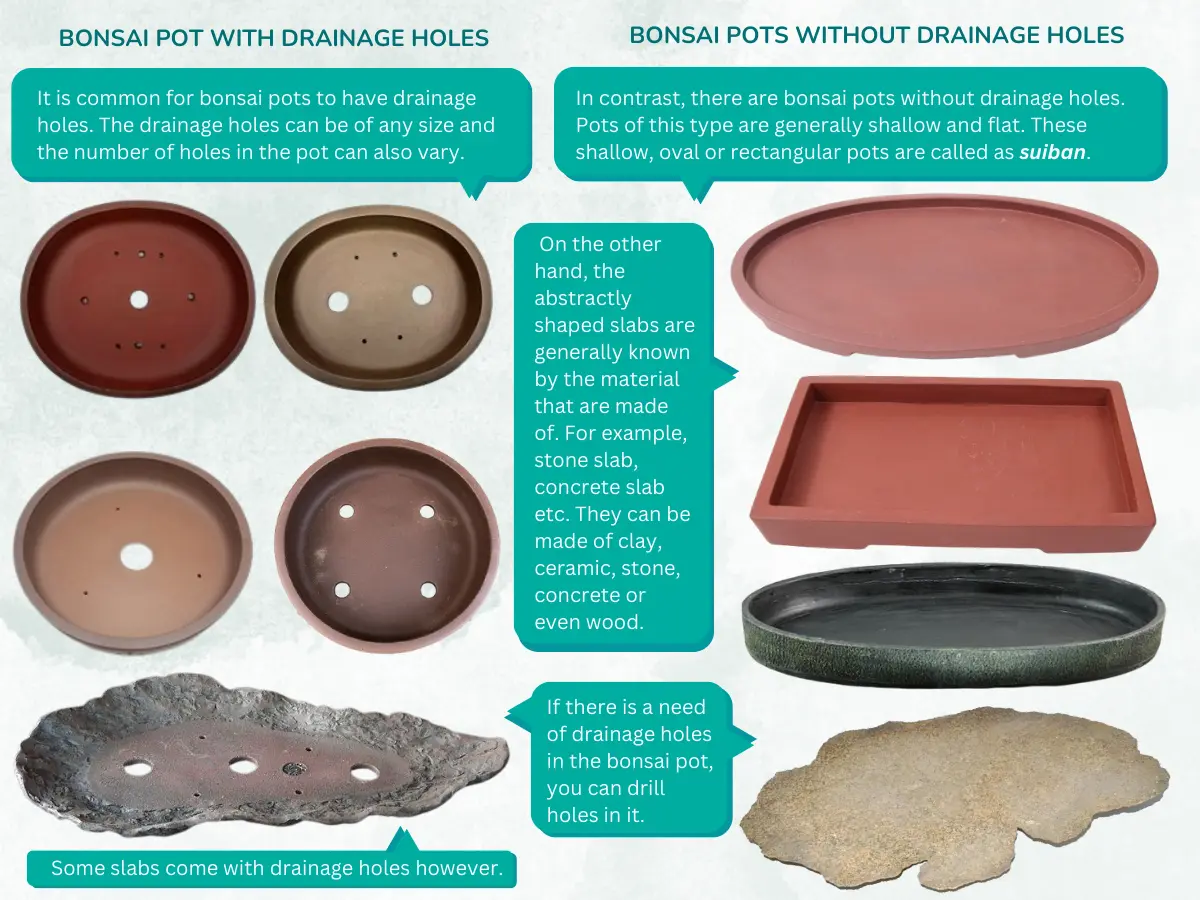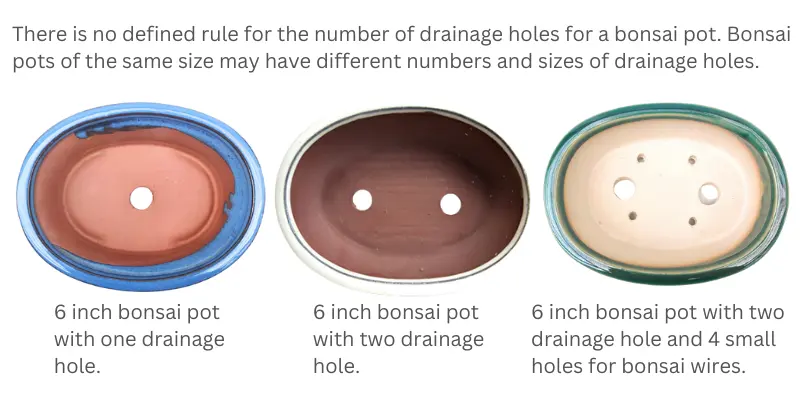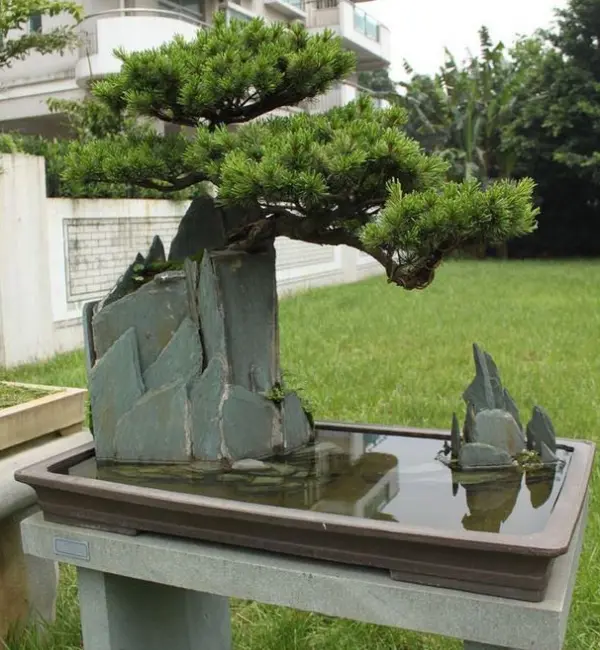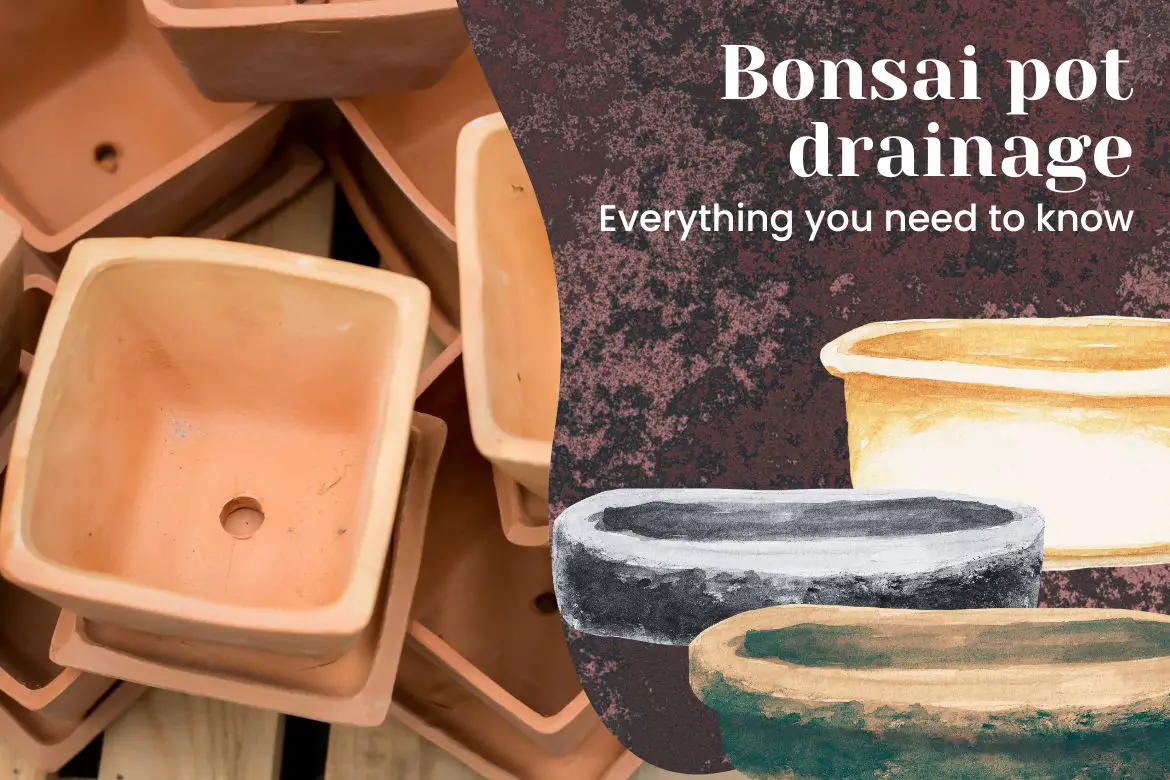Proper drainage is a vital aspect of growing a bonsai (as with any other plant), and the choice of bonsai pot plays a crucial role in ensuring the health and well-being of the tree.
Do bonsai pots need drainage holes
Yes, bonsai pots do need drainage holes. These holes prevent water from pooling at the bottom of the pot, which can lead to waterlogging, root rot and possibly the death of the bonsai tree. Adequate drainage is crucial to maintain a balanced moisture level in the soil and ensure the health and vitality of the bonsai tree. The drainage holes in bonsai pots enable the excess water to freely flow out, preventing waterlogging.
Some type of bonsai trees can survive excess watering however other bonsai tree varieties such as Japanese maple bonsai.
These holes also felicitate in proper aeration/oxygenation of the roots.
Furthermore, the drainage holes in the pot allow excess fertilizer salts to be flushed from the soil through the holes. Fertilizer salt burn can occur on the root and shoot tips of your bonsai tree due to a lack of drainage.
Last but not least, drainage holes also help fix wires to the pot to support the bonsai tree. This helps to keep the bonsai tree stable, especially in shallow pots.
In case you have over-watered your bonsai, you can try tilting your bonsai pot or in extreme cases repotting the bonsai tree.
Meanwhile, drainage holes also increase the risk of pests entering the bonsai soil through them. Hence, keep the bonsai pot on a raised platform to avoid this issue. Continue reading how to keep your bonsai tree pest free.
Do all bonsai pots have drainage holes?
While most bonsai pots are designed with drainage holes, it’s important to note that not all bonsai pots have them. Some decorative bonsai pots or display containers such as suiban pots (shallow flat containers for group plantings) may lack drainage holes due to aesthetic considerations or the type of bonsai style. For example, Saikei (landscape bonsai style) or Suiseki (waterfall bonsai style).

There are also abstractly shaped slabs used as bonsai pots. These slabs are generally known by the material that are made of. For example, stone slab, concrete slab etc. They can be made of clay, ceramic, stone, concrete or even wood. Some slabs come with drainage holes and some don’t.
In general, these pots and slabs do not have drainage holes since the location of the holes is decided by the bonsai grower based on the composition of the group or landscape bonsai he plans to create. In most cases, bonsai growers drill their own holes in these pots.
Furthermore, another reason why these pots do not have drainage holes as the bonsai grower might decide to keep some water on the pot to mimic a water body in his landscape bonsai. Drainage holes will lead to leaking of water.

How do you drill a hole in a bonsai pot?
In order to drill through the bottom of the pot, it is best to use a slow speed and a steady, gentle pressure. Make sure that you do not use the wrong bit or push too hard in order to avoid damaging the container. If you are uncertain about how the bonsai pot material will react, spray water on the surface as you drill.
Whenever possible, it is preferable to use one or two large drainage holes with a diameter of 0.5 to 1 inch ( 1.25 – 2.5 cm ) in a pot rather than numerous small holes that can become clogged easily over time.
To make holes in the bottom of a metal container, you can use a scratch awl/punch and hammer to make holes in the bottom. Rotate the awl inside the holes to make them as wide as you need them to be.
Following are some drill bit recommendations for different types of bonsai pot materials.
- If the container is made of plastic or resin, it should be drilled with a spur-point bit or plastic drill bit.
- In order to drill a hole in terracotta or concrete containers, you will need a drill equipped with a masonry bit.
- In order to drill ceramic or glass containers, it is recommended that a drill fitted with a tile bit be used.
- To punch holes in metal containers, you need either scratch punches and hammers, or high-speed steel drill bits (HSS) to drill holes into them.
- If you are drilling into a wood container, you can use a spade or twist bit on your drill in order to get a good grip on the wood.
How many holes should a bonsai pot have?
The number of drainage holes in a bonsai pot can vary, but it is generally recommended to have multiple holes for efficient water drainage. The exact number of holes depends on the size of the pot and the preferences of the bonsai grower. There is no rigid rule for number of drainage holes in a bonsai pot.
Bonsai pots of the same size may have different numbers and sizes of drainage holes.
Typically, bonsai pots have anywhere from one to several drainage holes evenly distributed across the bottom surface. The size of the drainage holes should be appropriate to allow water to drain efficiently without causing the soil to wash away. To prevent wash away of the soil, drainage mesh are used.

What is a bonsai pot without drain holes?
Unlike traditional bonsai pots, suiban pots lack drainage hole. These pots are shallow and flat. Originating from Japan, suiban pots are specifically designed for displaying landscape-style bonsai compositions.
These pots are typically made of materials such as ceramic, concrete, stone, wood or metal, and they have a low profile with a wide, open surface area.
Suiban pots are versatile and offer artistic opportunities for arranging rocks, sand, moss, and miniature trees to create captivating scenes that evoke a sense of tranquility and harmony with nature.
A bonsai pot without drainage serves two purposes:
(1) The absence of drainage holes allows the suiban pot to hold water, creating the illusion of a natural landscape or water feature within the bonsai display.

(2) These also give the bonsai grower the freedom of determining the number and location of drainage holes in the pot. It is important to remember that bonsai pot holes are not just for drainage, but also for tying bonsai wires to keep bonsai trees stable. As an example, if the grower decides to grow forest style bonsai rather than rock planting, wires will be necessary to keep the trees stable in these shallow pots. By being able to choose where the holes are drilled, bonsai growers can stick to their desired bonsai design without compromise.
What do you put at the bottom of a bonsai pot?
Generally, many bonsai growers put a thin drainage layer at the bottom of the bonsai pot before filling it with bonsai soil.
It is not necessary to create a drainage layer if you are using a shallow pot. In a deep pot, however, make a drainage layer of large, sterilized, coarse grit or gravel, and then add your soil mix. That being said, it should not be necessary to add a drainage layer in the pot if the bonsai soil is sufficiently free-draining.
Grit is also known as aggregate or sand. Grit particles should measure between 1/16 in and 1/4 in (2mm and 6mm) in diameter. Even though you can buy both rough and smooth grit (1mm to 2mm size), rough is preferable. It is important to wash the grit well to remove the dust.
There are also other things that can be used to make drainage layer such as Chicken or Turkey Grit, small gravel or pebbles.
However, avoid aquarium Gravel, river sand and builder’s sand. Aquarium gravel is highly polished or artificially colored. There is even a possibility that they are coated with a substance that will make them glow under black light. River sand on the other hand can have its edges rounded because of the flow of the river. Hence, there might be no beneficial cracks and crevices for roots, moisture, nutrients, or helpful bacteria. Builder’s sand contains either too much lime or is too fine, so do not use it.
Should I put rocks in bottom of bonsai pot?
Don’t put rocks in the bottom of the bonsai pot. You are more likely to cause harm than good by putting rocks at the bottom of the pot. Due to its size, rock can cover the drainage hole completely, thereby impeding water drainage. Because of its weight, rock will also damage the drainage mesh on the drainage holes, increasing the risk of soil washing away.
If you are adding a drainage layer, use a layer of grit, small gravel or pebbles instead of rocks. Moreover, if you have a shallow pot, there is no need to add a drainage layer. This is for 2 reasons. First, bonsai soil is free draining already, and second, there is not much space for soil in a shallow pot.
Do bonsai trees need good drainage?
Yes, bonsai trees require good drainage for their overall health and well-being. Adequate drainage is essential to prevent waterlogging and ensure that excess water can freely flow out of the pot. Proper drainage allows for the removal of stale or stagnant water, which can lead to root rot and other issues. It helps maintain a well-balanced moisture level in the soil, preventing overwatering and promoting aeration/oxygenation of the roots.
Furthermore, proper drainage will also help drain excess fertilizer from the soil, as excess salt in the soil can cause root burn.
Some types of bonsai trees such as Japanese maple bonsai are especially prone to overwatering. Hence, for such trees, having an effective drainage is a top priority. On the other hand, there are other trees such as weeping willow bonsai or birch bonsai that will tolerate a little bit of overwatering. Hence, for such trees, even a decent level of drainage will work.
To sum it up, a good drainage is a must for all bonsai trees. However, I would like to add one more thing. Apart from ensuring good drainage, it is also important to know the watering needs of your bonsai tree. As bonsai trees differ in water requirements, you must know how much to give each tree. Continue reading Bonsai tree varieties to know water requirements of all the bonsai trees.
What is the best drainage for bonsai?
The best drainage for bonsai is achieved through a well-balanced soil mix that consists of a combination of components that promote good drainage, aeration, and moisture retention.
The mix typically includes components such as Akadama (a type of clay), pumice, and lava rock. If you wish to make a soilless growing medium, you can mix equal parts of perlite and peat moss. These are just a few examples. Additionally, the ratio of components can vary from tree to tree. Please read Bonsai soil and recipes for more details. If you do not want to make your own bonsai mix, there are also proprietary bonsai soil mixes available commercially.
Akadama is known for its water retention properties, while pumice and lava rock contribute to the soil’s porosity and facilitate drainage. These components work together to create an optimal environment for the bonsai tree’s roots, allowing for the right balance of moisture and oxygen.
You can also add a layer of grit or fine gravel at the bottom of the bonsai pot to act as a drainage layer. However, this should only be done in large pots and not shallow pots.
It’s important to note that the specific soil mix may vary depending on the species of bonsai and the local climate. Regular monitoring of soil moisture levels and adjusting the watering routine accordingly is also crucial for maintaining proper drainage and preventing waterlogging.

